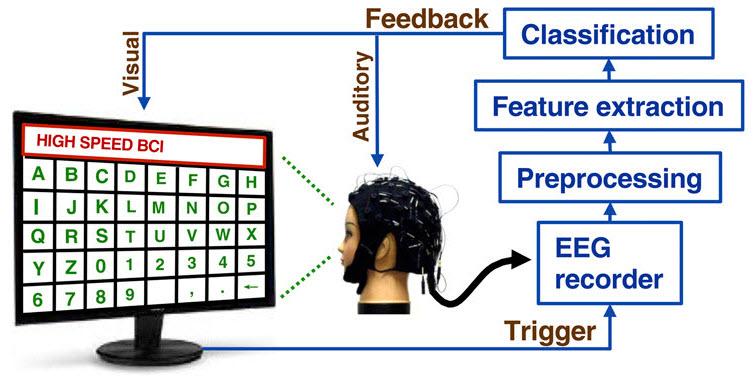Fastest brain-computer-interface speller developed
November 5, 2015

System diagram of the advanced SSVEP-based BCI speller. It consists of four main procedures: visual stimulation, EEG recording, real-time data processing, and feedback presentation. The 5 × 8 stimulation matrix includes the 26 letters of the English alphabet, 10 numbers, and 4 symbols (space, comma, period, and backspace). The image of the screen stimulation matrix shown here is only for illustration. (credit: Xiaogang Chen et al./PNAS)
Brain–computer interface (BCI) spellers allow a paralyzed patient to spell out words by looking at letters on a screen. Paralyzed patients can communicate by gazing at different letters to spell out a word.
Currently, the most advanced systems for doing this use “steady state visually evoked potential” (SSVEP). This method tags different characters on a screen by flashing each character at a different frequency (from 3.5 Hz to 75 Hz in one system). When a patient looks at a specific flashing character, the brain generates evoked electrical activity at the same (or multiples of) the specific frequency of the visual stimulus. This video demonstrates how that works:
Nikolay Chumerin |SSVEP-based mindspeller
However, the low communication rate (low number of characters per minute) for existing SSVEP systems is a remaining obstacle to improving BCI-based communication. That’s because the tagged visual evoked potentials are difficult to detect due to interference from spontaneous EEG signals.
A new world record for BCI spellers claimed
Researchers at Tsinghua University in China and State Key Laboratory Integrated Optoelectronics, Institute of Semiconductors (IOS), Chinese Academy of Sciences have now developed a significantly improved SSVEP system. It can achieve rates of about 60 characters (∼12 words) per minute (5.32 bits per second) — a claimed new world record for BCI spellers, using either non-invasive or invasive methods.
To achieve that, the 40 characters in the stimulation matrix (used on the display) are tagged with a more sophisticated flickering frequency and phase coding scheme similar to that used in telecommunications systems, along with user-specific decoding. Real-time data analysis recognizes the target character through pre-processing, feature extraction, and classification.
The researchers suggest that the spelling speed achieved with this system (~1 character per second) seems close to the speed limit of human gaze control.
The research was published in Proceedings of the National Academy of Sciences. It was supported by the Chinese National Basic Research Program, the National High-Tech R&D Program, the National Natural Science Foundation, and the Recruitment Program for Young Professionals.
Abstract of High-speed spelling with a noninvasive brain–computer interface
The past 20 years have witnessed unprecedented progress in brain–computer interfaces (BCIs). However, low communication rates remain key obstacles to BCI-based communication in humans. This study presents an electroencephalogram-based BCI speller that can achieve information transfer rates (ITRs) up to 5.32 bits per second, the highest ITRs reported in BCI spellers using either noninvasive or invasive methods. Based on extremely high consistency of frequency and phase observed between visual flickering signals and the elicited single-trial steady-state visual evoked potentials, this study developed a synchronous modulation and demodulation paradigm to implement the speller. Specifically, this study proposed a new joint frequency-phase modulation method to tag 40 characters with 0.5-s-long flickering signals and developed a user-specific target identification algorithm using individual calibration data. The speller achieved high ITRs in online spelling tasks. This study demonstrates that BCIs can provide a truly naturalistic high-speed communication channel using noninvasively recorded brain activities.